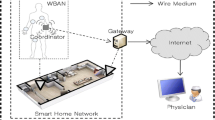Abstract
Wireless sensor networks have recently been extensively researched due to the flexibility and cost savings they provide. One of the most promising applications of sensor networks is human health monitoring: wireless sensors are placed on the human body to form a wireless body network where the sensor node can continuously monitor real-time physiological parameters or human activities (motion detection). However, along with the flexibility, many problems arise due to a number of factors, including the bad quality of transmission media and the scarcity of resources. Moreover, sensor networks have different characteristics such as a variety of devices, different generated data, etc. From a quality of service (QoS) point of view, the healthcare domain can be seen as a real-time application demand to consider application requirements. Healthcare domains principally have stringent delay and loss requirements. Thus, considering different capabilities and ensuring time data delivery become necessary. Because wireless body area networks (WBAN) deal with human life, any delayed or lost data can endanger the user’s life. This paper proposes a differentiated traffic and scheduling scheme for WBAN. It is based on patients’ data classification and prioritization according to their current status and diseases. Through queue scheduling and path choice issues, the urgent data are delivered on time to provide a QoS guarantee for WBAN. Finally, it is shown that the proposed scheme is efficient for timely data transfer in WBAN.
Similar content being viewed by others
References
Ullah, S. et al. (2010). A comprehensive survey of wireless body area networks. Journal of medical system, 36(3), 1065–1094.
Kateretse, C., & Huh, E. N. (2011). An efficient data transmission scheme for ubiquitous healthcare using wireless body area networks. ICSECS.
Hande A., Ersoy C. (2010) Wireless sensor networks for healthcare: A survey. Computer Networks 54: 2688–2710
Cao H., Leung V., Chow C., Chan H. (2009) Enabling technologies for wireless body area networks: A survey and outlook. IEEE Communication Magazine 17(12): 84–93
She H., Lu Z. (2007) Network-based system architecture for remote medical applications. Asia-Pacific Advanced Network, China
Yoon, J. S., Gahng-Seop, A., Seong-Soon, J., et al. (2010). PNP-MAC: Preemptive slot allocation and non-preemptive transmission for providing QoS in body area networks. In: IEEE consumer communications and networking conference (CCNC) (pp. 1–5).
Ali, K. A., Sarker, J. H., & Mouftah, H. T. (2010). Urgency-based MAC protocol for wireless sensor body area networks. In: International conference on communications workshops (pp. 1–6), Capetown.
Otal, B., Alonso, L., & Verikoukis, C. (2008). Novel QoS scheduling and energy-saving MAC protocol for body sensor networks optimization. In: Proceedings of the ICST 3rd international conference on Body area networks (pp. 1–4), Tempe, AZ.
Liang, X., & Balasingham I. (2007). A QOS-aware routing service framework for biomedical sensor network. IEEE ISWCS.
Hossien, M. (2010). A novel congestion control protocol for vital signs monitoring in wireless biomedical sensor networks. IEEE WCNC.
Dessart, N., Fouchal, H., Hunel, P., & Vidot, N. (2010). Anomaly detection with wireless sensor networks. IEEE NCA.
Suzuki, T., & Kameyama, K. (2010). Development of a sleep apnea event detection method using photoplethysmography. In 32th annual international conference of the IEEE EMBS.
Yung Cheng, W., Tsu-Yun, L. (2009). A WSN- based wireless monitoring system for intradialytic hypertension of dialysis patients. IEEE sensors.
Peng, R., Sichitiu, M. L. (2007). Probabilistic localization for outdoor wireless sensor networks, ACM SIGMOBILE.
Gross D., Shortle J., Thompson J., Harris C. (2008) Fundamentals of queuing theory (4th ed.). Wiley, Hoboken
Jovanov A., Milenkovic A., Otto C., De Greon P. (2005) A wireless body area network of intelligent motion sensors for computer assisted physical rehabilitation. JNER 2(6): 16–23
Hoasong, C., Gonzalez-Valenzuela, S., & Leung, V. C. M. (2010). Employing IEEE 802.15.4 for quality of service provisioning in wireless body area sensor networks. In International conference on advanced information networking and applications (pp. 902–909), Perth, WA.
Otal, B., Alonso, L., & Verikoukis, C. (2009). Highly reliable energy-saving MAC for wireless body sensor networks in healthcare systems. IEEE Journal on Selected Areas in Communications 27(4), 553–565. (Special issue on wireless and pervasive communications for healthcare).
Razzaque, M. A., Hong, C. S. (2010). Analysis of Energy-tax for Multipath Routing in Wireless Sensor Networks. Annals of telecommunications 65(1–2), 117–127.
Author information
Authors and Affiliations
Corresponding author
Rights and permissions
About this article
Cite this article
Kateretse, C., Lee, GW. & Huh, EN. A Practical Traffic Scheduling Scheme for Differentiated Services of Healthcare Systems on Wireless Sensor Networks. Wireless Pers Commun 71, 909–927 (2013). https://doi.org/10.1007/s11277-012-0851-8
Published:
Issue Date:
DOI: https://doi.org/10.1007/s11277-012-0851-8




